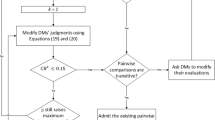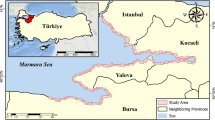Abstract
Analytic hierarchy process (Group AHP) is combined with two different methods of assigning experts’ priority to weight indicators in building energy efficiency assessment. One is to assign the experts’ priority averagely, and the other is to use cluster analysis to assign experts’ priority. The results show that, 1) Different expert’s priority assigns result in great different weights of indicators in building energy efficiency assessment, therefore, the method of assigning experts’ priority should be taken into account carefully while weighting indicators of building energy efficiency assessment using Group AHP; 2) Three indicators are found to be overwhelmingly important in residential building energy efficiency assessment in the hot summer and cold winter zone in China. They are ‘Outdoor & indoor shadow’, ‘Heating & air-conditioning facilities’ and ‘Insulation of envelope’; 3) The method combining cluster analysis with Group AHP to weight indicator of building energy efficiency assessment has the advantage of finding overwhelming important indicator, whereas, some less important indicators have a tendency to be ignored. A useful reference is provided for building energy conservation including policy revision and energy efficient residential building design.
Similar content being viewed by others
References
Ministry of Housing and Urban-Rural Development of China. Technical guides for building energy efficiency testing and labeling [EB/OL]. 2007-06. http://www.cin.gov.cn/zcfg/jswj/jskj//200611/t20061101_158522.htm. (in Chinese)
CHEN Zhen, CROOME D C, HONG Ju, LI Heng, XU Qian. A multi criteria lifespan energy efficiency approach to intelligent building assessment [J]. Energy and Building, 2006, 38: 393–409.
Ministry of Housing and Urban-Rural Development of China. Evaluation standard for green building. GB50378-2006 [S]. Beijing: China Architecture & Building Press, 2006. (in Chinese)
Ministry of Housing and Urban-Rural Development of China. Technical standard for performance assessment of residential buildings. GB/T50362-2005 [S]. Beijing: China Architecture & Building Press, 2005. (in Chinese)
Ministry of Housing and Urban-Rural Development of China. Evaluation standard for energy efficient buildings. GB/T 50668-2011 [S]. Beijing: China Architecture & Building Press, 2010. (in Chinese).
United States Green Building Council. Green building rating system version 2.0 leadership in energy and environmental design [M]. Beijing: China Architecture & Building Press, 2000: 1–10. (in Chinese).
Building Research Establishment. The environmental rating for homes-The guidance-2006/issue 1.2[EB/OL]. http://www.breeam.org.
BIRT B J, NEWHAM G R. Post-occupancy evaluation of energy and indoor environment quality in green buildings: A review [C]// Proceedings of the SASBE 2009 Conference. The Netherlands: Delft University of Technology, 2009: 1–8.
WANG Jian-hua. Assessment on comprehensive energy-conserving result of buildings [J]. Industrial Construction, 2006, 36(1): 19–21. (in Chinese).
LIU Ai-fang, ZHANG Cai-qing, DUAN Ru. Construction of evaluation criterion system of building energy conservation [J]. Power DSM, 2006, 8(1): 39–42. (in Chinese).
DING Li-xing, LI Yue-ming, BAO Jing-song. The construction of comprehensive assessment indicators system of building energy conservation in hot summer cold winter zone [J]. Architecture and Construction, 2003(12): 19–22. (in Chinese).
Ministry of Housing and Urban-Rural Development of China. Design standard for energy efficiency of residential buildings in the hot summer and cold winter zone. JGJ 134-2001 [S]. Beijing: China Architecture & Building Press, 2010. (in Chinese)
CONG Na, WU Chen-dong, DING Jun-de. Comprehensive evaluation criterion system of building energy conservation [J]. Intelligent Building, 2007(9): 47–49. (in Chinese).
YANG Yu-lan, LI Bai-zhan, YAO Run-ming. A method of identifying and weighting indicators of energy efficiency assessment in Chinese residential buildings [J]. Energy Policy, 2010(38): 7687–7697.
ROBERT F D, EMEST H F. Group decision support with the analytic hierarchy process [J]. Decision Support Systems, 1992, 8(2): 99–124.
WU Qiang. Research on some key theoretical problems & methods of Intelligent group decision support system [D]. Hefei: University of Science and Technology of China, 2006. (in Chinese)
GAO Yang, LUO Xian-xin, HU Ying. Research on method for deriving experts’ weights based on judgement matrix and cluster analysis [J]. System Engineering and Electronics, 2009, 31(3): 594–596. (in Chinese).
WU Yun-yan, HUA Zhong-sheng, ZHA Yong. Calculation of the weights and the amalgamation of the matrixes in AHP Group decision [J]. Operation Research and Management Science, 2003, 12(2): 17–21. (in Chinese).
SAATY T L. The analytic hierarchy process: Planning, priority setting, resource allocation [M]. Pittsburgh: University of Pittsburgh, 1990: 12.
Author information
Authors and Affiliations
Corresponding author
Additional information
Foundation item: Project(2010R10036) supported by the Science and Technology Department of Zhejiang Province, China
Rights and permissions
About this article
Cite this article
Yang, Yl., Tai, Hx. & Shi, T. Weighting indicators of building energy efficiency assessment taking account of experts’ priority. J. Cent. South Univ. Technol. 19, 803–808 (2012). https://doi.org/10.1007/s11771-012-1075-5
Received:
Accepted:
Published:
Issue Date:
DOI: https://doi.org/10.1007/s11771-012-1075-5




